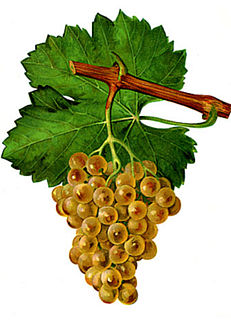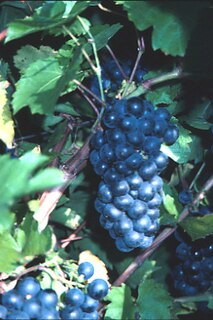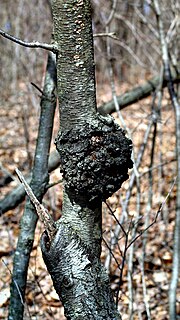
Penicillium is a genus of ascomycetous fungi that is part of the mycobiome of many species and is of major importance in the natural environment, in food spoilage, and in food and drug production.

Botrytis cinerea is a necrotrophic fungus that affects many plant species, although its most notable hosts may be wine grapes. In viticulture, it is commonly known as "botrytis bunch rot"; in horticulture, it is usually called "grey mould" or "gray mold".

Late harvest wine is wine made from grapes left on the vine longer than usual. Late harvest is usually an indication of a sweet dessert wine, such as late harvest Riesling. Late harvest grapes are often more similar to raisins, but have been naturally dehydrated while on the vine.

Sémillon is a golden-skinned grape used to make dry and sweet white wines, mostly in France and Australia. Its thin skin and susceptibility to botrytis make it dominate the sweet wine region Sauternes AOC and Barsac AOC.

Chelois is a variety of hybrid grape used in the production of red wines. The fruit are small blue-black berries, which appear in compact, medium-sized clusters. Chelois is among the less hardy hybrids of red-wine grapes.
A wine fault or defect is an unpleasant characteristic of a wine often resulting from poor winemaking practices or storage conditions, and leading to wine spoilage. Many of the compounds that cause wine faults are already naturally present in wine but at insufficient concentrations to be of issue. In fact, depending on perception, these concentrations may impart positive characters to the wine. However, when the concentration of these compounds greatly exceeds the sensory threshold, they replace or obscure the flavors and aromas that the wine should be expressing. Ultimately the quality of the wine is reduced, making it less appealing and sometimes undrinkable.

Black rot is a name used for various diseases of cultivated plants caused by fungi or bacteria, producing dark brown discoloration and decay in the leaves of fruit and vegetables:

Dead arm, sometimes grape canker, is a disease of grapes caused by a deep-seated wood rot of the arms or trunk of the grapevine. As the disease progresses over several years, one or more arms may die, hence the name "dead arm". Eventually the whole vine will die. In the 1970s, dead-arm was identified as really being two diseases, caused by two different fungi, Eutypa lata and Phomopsis viticola.
Microfungi or micromycetes are fungi—eukaryotic organisms such as molds, mildews and rusts—which have microscopic spore-producing structures. They exhibit tube tip-growth and have cell walls composed of chitin, a polymer of N-acetylglucosamine. Microfungi are a paraphyletic group, distinguished from macrofungi only by the absence of a large, multicellular fruiting body. They are ubiquitous in all terrestrial and freshwater and marine environments, and grow in plants, soil, water, insects, cattle rumens, hair, and skin. Most of the fungal body consists of microscopic threads, called hyphae, extending through the substrate in which it grows. The mycelia of microfungi produce spores that are carried by the air, spreading the fungus.

Penicillium expansum is a psychrophilic blue mold that is common throughout the world in soil. It causes Blue Mold of apples, one of the most prevalent and economically damaging post-harvest diseases of apples.

Sclerotinia sclerotiorum is a plant pathogenic fungus and can cause a disease called white mold if conditions are conducive. S. sclerotiorum can also be known as cottony rot, watery soft rot, stem rot, drop, crown rot and blossom blight. A key characteristic of this pathogen is its ability to produce black resting structures known as sclerotia and white fuzzy growths of mycelium on the plant it infects. These sclerotia give rise to a fruiting body in the spring that produces spores in a sac which is why fungi in this class are called sac fungi (Ascomycetes). This pathogen can occur on many continents and has a wide host range of plants. When S. sclerotiorum is onset in the field by favorable environmental conditions, losses can be great and control measures should be considered.

Phomopsis obscurans is a common fungus found in strawberry plants, which causes the disease of leaf blight. Common symptoms caused by the pathogen begin as small circular reddish-purple spots and enlarge to form V-shaped lesions that follow the vasculature of the plant's leaves. Although the fungus infects leaves early in the growing season when the plants are beginning to develop, leaf blight symptoms are most apparent on older plants towards the end of the growing season. The disease can weaken strawberry plants through the destruction of foliage, which results in reduced yields. In years highly favorable for disease development, leaf blight can ultimately lead to the death of the strawberry plants. A favorable environment for the growth and development of the Phomopsis obscurans pathogen is that of high temperature, high inoculum density, a long period of exposure to moisture, and immature host tissue. In the case of disease management, a conjunction of cultural practices is the most effective way of reducing the infection.

Phomopsis is a genus of ascomycete fungi in the family Valsaceae.
This glossary of viticultural terms list some of terms and definitions involved in growing grapes for use in winemaking.
P. viticola may refer to:
Cladosporium fulvum is an Ascomycete called Passalora fulva, a non-obligate pathogen that causes the disease on tomato known as the tomato leaf mold. P. fulva only attacks tomato plants, especially the foliage, and it is a common disease in greenhouses, but can also occur in the field. The pathogen is likely to grow in humid and cool conditions. In greenhouses, this disease causes big problems during the fall, in the early winter and spring, due to the high relative humidity of air and the temperature, that are propitious for the leaf mold development. This disease was first described in the North Carolina, by Mordecai Cubitt Cooke (1883), on cultivated tomato, although it is originally from South and Central America. The causal fungus of tomato leaf mold may also be referred to as Cladosporium fulvum, a former name.

Cladosporium cladosporioides is a darkly pigmented mold that occurs world-wide on a wide range of materials both outdoors and indoors. It is one of the most common fungi in outdoor air where its spores are important in seasonal allergic disease. While this species rarely causes invasive disease in animals, it is an important agent of plant disease, attacking both the leaves and fruits of many plants. This species produces asexual spores in delicate, branched chains that break apart readily and drift in the air. It is able to grow under low water conditions and at very low temperatures.

Botrytis elliptica is a necrotrophic fungal pathogen which infects species of plants in the Lilium genus, causing the disease commonly known as Lily Gray Mold. The symptoms of Lily Gray Mold include the appearance of water-soaked spots on leaves which appear white and increase in darkness with age, ranging from gray to brown. These spots may cover the entire leaf, complemented with a gray webbing, containing the fungal spores. The leaves will appear wilted and branches may die back. In addition to leaves, petals, stems, and buds may be infected, and this gray webbing will eventually cover the plant, feigning the appearance of gray flowers. Infected buds often rot. Lily Gray Mold disease, if not properly treated, will appear each year with increasing vigor.












